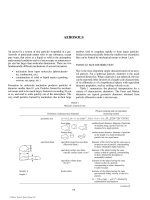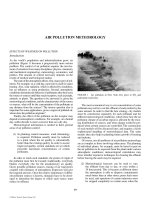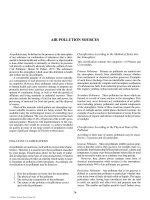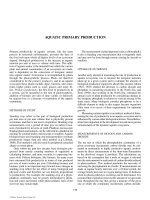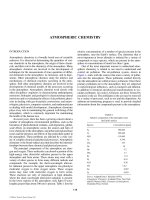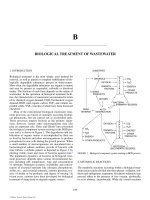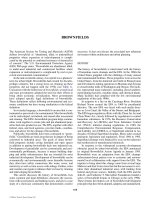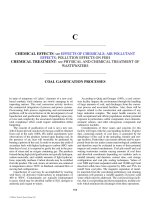ENCYCLOPEDIA OF ENVIRONMENTAL SCIENCE AND ENGINEERING - CHEMICAL EFFECTS: see EFFECTS OF CHEMICALS; AIR POLLUTANT EFFECTS; POLLUTION EFFECTS ON FISH CHEMICAL TREATMENT: see PHYSICAL AND CHEMICAL TREATMENT OF WASTEWATERS potx
Bạn đang xem bản rút gọn của tài liệu. Xem và tải ngay bản đầy đủ của tài liệu tại đây (167.6 KB, 5 trang )
166
C
CHEMICAL EFFECTS : see EFFECTS OF CHEMICALS; AIR POLLUTANT
EFFECTS; POLLUTION EFFECTS ON FISH
CHEMICAL TREATMENT : see PHYSICAL AND CHEMICAL TREATMENT OF
WASTEWATERS
COAL GASIFICATION PROCESSES
In spite of temporary oil “gluts,” elements of a new coal-
based synthetic fuels industry are slowly emerging in oil
importing nations. This coal conversion activity involves
the commercial integration of process and power systems.
Overcoming both process engineering and environmental
problems will be crucial factors in the development of coal
liquefaction and gasification plants. Depending upon proj-
ect size and complexity, the associated expenditures for the
total compliance effort could require multimillion dollar
budgeting.
The concept of gasification of coal is not a new one.
John Clayton proved conclusively that gas could be obtained
from coal in the early 1680s. His initial experiments were
observations of the products formed upon heating coal. In
the presence of air, heat will invariably be generated by
burning a portion of the coal. In order to increase the yield of
secondary fuels with higher hydrogen to carbon (H/C) ratio
than that of coal, it is required to gasify the coal in the pres-
ence of steam and an oxygen containing gas. The products
formed during high yield gasification are typically hydrogen,
carbon monoxide, and variable amounts of light hydrocar-
bons, especially methane. Carbon dioxide may be scrubbed
from the product. The coal, steam, air mixtures are contacted
at temperatures above 700°C in fluidized, entrained flow or
moving bed configurations.
Liquefaction of coal may be accomplished by reacting
with heavy oil derivative hydrocarbons at temperatures of
400 to 500°C. Contaminants are typically hydrogenated
to gases which may be absorbed (sulfur to H
2
S, nitrogen to
ammonia and oxygen to water).
According to Quig and Granger (1983), a coal conver-
sion facility impacts the environment through the handling
of large amounts of coal, and discharges from the conver-
sion process and associated facilities. Also, there will be
impacts related to the construction and operation of any
large industrial complex. The major health concerns for
both occupational and offsite populations include potential
exposure to particulates, sulfur compounds, trace elements,
aromatic amines, and other nitrogenous compounds and
radioactive nuclides.
Considerations of these issues and concerns for this
facility will begin with the coal handling facilities. Fugitive
dust, consisting mainly of coal fines, is generated by the
disturbance of the coal in the unloading, transfer and stor-
age facilities. Particulates can remain airborne and be trans-
ported from the site under certain meteorological conditions
and therefore must be evaluated in terms of their potential
impacts and control mechanisms. Coal pile runoff and coal
wetting wastewater contain varying amounts of coal fines
and dissolved constituents depending on variables such as
rainfall intensity and duration, contact time, coal storage
configuration and coal pile sealing techniques. Values of
over 2000 mg/l total suspended solids and 10,000 mg/l total
dissolved solids have been reported by EPA and TVA for
runoff from coal piles. The magnetic separation of metal-
lic materials from the coal during preliminary coal cleaning
operations will generate a variable quantity of pyretic solid
waste which must be addressed. The coal processing facili-
ties, that is coal grinding and slurry preparation, include con-
trols which minimize the discharges from these operations.
© 2006 by Taylor & Francis Group, LLC
COAL GASIFICATION PROCESSES 167
Some of the more important coal gasification processes
include those of Texaco, Shell, Dow & British Lurgi. These
are carried out at high temperature 600 to 3000°F and high
pressure 25 to 80 atmospheres. The most developed process
is Cool Water integrated gasification/combined cycle (IGCC)
described by Holt (1988) and Spencer et al. (1986) which
uses a Texaco gasifier. Makansi (1987) compares the per-
formance of various systems. Important emissions data for
IGCC projects are presented at the end of the current review.
Additional information is presented below on the status
of coal gasification environmental effects. A comparison of
the impacts on water streams of various processes is given
in Table 1.
Pruschek et al. (1995) discusses the removal of pollut-
ants from a coal gasification plant in a more efficient and
economical manner than in previous designs by conserving
energy in the cleaning sections of the plant. A zinc titanate
catalyst is being tested for hot (1000°F) gas cleanup potential
at Tampa Electric’s 260 MW coal gasification power plant in
Lakeland, Fla.
Waste gas emissions are reduced by scrubbing the raw
gases leaving the gasifier in an acid gas removal system
and converting the H
2
S (via a modified Claus process) to
sulfur. Sulfur dioxide is thus drastically reduced in the final
stack emissions. NO
x
levels are reduced by saturating the
gas prior to gas turbine combustion (see Spencer 1986) or
Makansi (1987). Advances in process efficiency are pos-
sible, through the use of a combined cycle configuration
the Shell Coal gasification process. The product gas would
typically be fired in a combustion turbine followed by an
HRSG and a steam turbine (i.e., combined cycle) to com-
plete the IGCC. Heitz (1985) presented data on end uses of
From an economic point of view it is desirable to con-
struct an IGCC in phases, Le et al. (1986). In the typical
scenario the first phase would be installation of simple cycle
gas turbines for peaking power. As of 1989 the maximum
single gas turbine output is about 150 MW. In the second
phase a heat recovery boiler is used to generate steam for
either cogeneration or to power a steam turbine (i.e., ordi-
nary combined cycle). Zaininger Engineering (Lewis, 1988)
indicate that there is an optimum time at which the gasifier
plant could be added as fuel cost/availability would dictate.
Normal combined cycle efficiency can be approximately
50% (LHV) whereas IGCC values range from 37 to 42%.
However, new hot gas cleanup processes (such as limestone
throwaway or metal oxide catalyst) are being developed
which may increase IGCC efficiency to about 48%.
TABLE 1
Coal gasification wastewater concentrations (mg/l, unless noted otherwise). (Adapted from Epstein, 1987)
Component
KILnGAS
(Illinois No.
6) Moving
Bed
Lurgi
Dry Ash
(Montana
Rosebud)
Moving Bed
Lurgi
Dry Ash
(High-Sulfur
Eastern Coal
at Sasol)
Moving Bed
Lurgi Dry
Ash (Lignite
at Kosovo)
Moving Bed
British
Gas-Lurgi
Slagger
(Pittsburgh
No. 8)
Moving Bed
Grand Forks
Slagger
(Lignite)
Moving Bed
HYGAS
(Illinois No. 6)
Fluidized Bed
Texaco
(Illinois
No. 6)
Entrained
Flow
Chemical oxygen
demand
(COD)
4100–6100 21,000–
23,000
12,000 20,000 20,000 25,400 4050 1100
Total organic
carbon (TOC)
810–1610 — 3500 6000 — — — —
Total phenols 260–660 4200–4400 3800 3000 3000 5100 710 <1
Cyanides and
thiocynates
130–300 8–19 <3 80 1150 150 30 50
Total nitrogen 1200–2300 — — 4300 — 5200 3700 —
Ammonia 840–1700 4000–14,000 7000 3700 3000 — — 2100
Total sulfur 430–1030 — 950 — 700 — — —
Chloride 450–710 40–45 670 — 1500 — — 3500
Total suspended
solids (TSS)
150–700 — ———— — —
Total dissolved
solids (TDS)
1070–2100 1700–4000 — 2000 7000 — — 2220
Oil and grease 25–340 — 50 900 — 300 — 6
pH 8.3–8.8 8–10 9 9 9 — — —
Temp. °F, 100s — 9–12 9–12 9–12 9–12 — 16–18 24–28
© 2006 by Taylor & Francis Group, LLC
various gasifier process streams (see Table 2). The analysis
of a typical product gas stream appears in Table 3.
and by reducing gasifier energy losses. Figure 1 illustrates
168 COAL GASIFICATION PROCESSES
Holt’s (1988) review of Cool Water data, are impressively
low for a coal-based plant. Sulfur dioxide in the gases leav-
ing the tail gas incinerator is about one fifth the quantity
leaving in the turbine exhaust stream. The turbine exhaust
did not contain sulfur compounds other than SO
2
.
A typical gasification process will generate both solid
and liquid wastes. The solid waste retains the natural impu-
rities inherent in the coal such as heavy metals, chlorides
as well as organic compounds formed by the combustion of
coal in the reactor. Testing, as defined in rules and regula-
tions under Section 3001 of the 1976 Resource Conservation
and Recovery Act RCRA, must be conducted to determine
the nature of the solid waste generated by the gasifica-
tion of the particular coal with the specified process. The
wastewater stream exiting the carbon-ash scrubbers may
contain dissolved and suspended fly ash and unconverted
carbon trapped in the scrubber. The treatment of this process
wastewater for discharge will generate sludge which will
have to be controlled and assessed.
A gasification process may not have any atmospheric
emissions during normal operating conditions. Gases are
processed and recirculated so that the desired discharge from
the system is product gas alone. During upset conditions,
however, venting will occur causing releases of gaseous
wastes.
Sources of non-gasifier liquid wastes which must be
evaluated include blowdown from clarifiers and cooling
towers, drainage from equipment and floor areas, demin-
eralizer wastes and sanitary wastes. Contaminants in these
streams are generally a function of the intake water quality
and any chemical additives.
Coal
Coal Receiving
and Storage
Coal Milling
and Drying
Coal Feed
System
Steam to
Utilization
Steam to
Utilization
High
Temperature
Cooling
Solids
Removal
and Cooling
Acid
Gas
Removal
Acid Gas to
Sulfur Recovery
Water Recycle
Water
Treatment
To Biotreater
Product Gas
to Power
Generation
Slag to
Utilization
To
Utilization
Oxygen
Gasifier
Quench Gas
BFW
BFW
FIGURE 1 Shell coal gasifi cation process block fl ow diagram for SCGP-1.
TABLE 2
Uses of products, co-products and effluents (from Heitz, 1985)
Product gas Power generation
Steam General steam system
Acid gas Sulfur plant/sulfur sales
Slag and ash Roads, fill, other products
Runoff and stripped Biotreater
© 2006 by Taylor & Francis Group, LLC
The stack emission values presented in Table 4, as per
The main problems found with sulfur sorbents involve
mechanical property degradation and/or loss of sulfur capac-
ity over many sulfidation-regeneration cycles. The sorbents
receiving the most attention are all zinc based. Building on the
Cool Water technology, various zinc titanate formulations and
proprietary materials were developed by the U.S. Department
of Energy (DOE)/Morgantown Energy Technology Center
(METC) and used at Tampa Electric—Swisher et al. (1995).
A hot gas pilot scale desulfurization is currently operating
at METC. It uses a simulated coal gas mixture at volumetric
flow rates of up to 120,000 standard cubic feet per hour and
400 psia and up to 1200°F. Fluidized bed technology is ideal
for reactors that continuously circulate reactive and regen-
erated adsorbent. For further information and updates the
reader is referred to the following publication and the DOE
websites:
and
One of the world’s largest coal gasification plants for elec-
tricity generation, a 253 MWe power plant based on the Shell
IGCC process, was built and started-up in Buggenum, in the
Netherlands, in 1994. Since October 2001, the installation has
been owned and operated by NUON Power as a fully com-
mercial electric generating unit. Pulverized coal is gasified at
about 400 psi and 2700°F using pure oxygen rather than air.
Fly ash bearing raw gas exiting the gasifier is passed through
cyclones to remove the larger particles. The remaining fines
are collected in a hot gas ceramic candle filter. The filter treats
about 1 million cubic feet per hour of syngas at about 500°F
and 380 psia. The filter contains tube modules with elements
made from a structure of silicon carbide supporting a porous
Mullite grain membrane with a pore size of about 4 × 10
−4
inch. Future plans include co-gasifying waste materials such
as biomass chicken litter, wood products and sewage sludge.
Further cleanup of the syngas involves removal of acid
gases such as COS, H
2
S and chlorides as well as a process to
pounds is included in the water treatment process.
Sources of non-gasifier solid wastes include sludge from
raw water treatment and spent bauxite catalyst from the
Claus unit, spent cobalt/molybdenum catalyst from the tail
TABLE 3
Typical treated product gas composition. (Adapted from Heitz, 1985 for SCGP-1)
Component % Volume (N
2
Free)
Hydrogen 30
Carbon monoxide 69
Carbon dioxide <0.1
Hydrogen sulfide <0.01
Carbonyl sulfide <0.01
Hydrogen cyanide <0.001
Ammonia <0.001
Hydrogen chloride <0.001
Hydrogen fluoride <0.001
Methane 0.03
Water 0.6
Argon 0.2
TABLE 4
Cool water stack emissions. (adapted from Holt 1988)
HRSG Emissions
(Lbs/Million Btu)
Incinerator
combustion
productsPollutant
U.S. EPA
NSPS
Cool Water
Permits*
Cool Water
Test Results**
NO
x
0.60 0.13 0.056 140 ppmv
SO
2
0.24 0.034 0.017 116 ppmv
Particulates 0.03 0.01 0.008 0.18 g/m
3
* Cool Water Permit for Low Sulfur Coal Operation (Low sulfur coal is defined in the per mit as coal containing
less than 0.7 wt.% sulfur).
** 1987 EPA Performance Test Results for SUFCo Coal, Holt (1988).
COAL GASIFICATION PROCESSES 169
© 2006 by Taylor & Francis Group, LLC
recover sulfur (see Fig. 1). Also removal of ammonia com-
/>96ps/ps_pdf/96ps1_5.pdf, />publications/proceedings/02/GasCleaning/1.05paper/pdf
170 COAL GASIFICATION PROCESSES
gas treatment, silica gel from the air separation plant, and
various resins from the water treatment plant.
Sources of non-gasifier atmospheric emissions are cool-
ing tower evaporation and drift, and the gas turbine. The
cooling tower releases will cause salt deposition in the sur-
rounding area. The nature and extent must be determined
and evaluated using intake water quality data, design infor-
mation and mathematical modeling. The on-site gas turbine
will emit low levels of NO
x
, SO
2
and particulates which will
have to be considered.
Other impacts associated with any large scale project are
those related to the construction of the plant. There will be
an increase in traffic by the construction work force on the
existing roads. There are potential construction work force
impacts related to workers immigration, shortage of cer-
tain skilled labor categories, etc. which must be assessed.
In addition, there is a potential for noise impacts during the
construction or operation of the facility.
The increase in traffic on the roads, rails and rivers near
a proposed site due to coal deliveries will create additional
demands on the system. The construction of a facility will
have unavoidable impacts on the land use at the site.
Construction and operation may impact on the surface
water bodies and the potable aquifers in the area but due
to the current state of waste water treatment technology,
minimal impact on water quality is expected after control
measures are applied.
The authors wish to acknowledge the work of Quig and
Granger (1983) in an earlier version of this article, some of
which appears here.
REFERENCES
Epstein, M., Elec. Pwr. Res. Inst. Jnl. pp. 39–42 Advanced Power System,
April/May (1987).
Heitz, W.L., Status of the Shell Coal Gasification Process (SCGP) presented
at 5th Annual EPRI Contr. Conference, Palo Alto, CA, Oct. 30 (1985).
Holt, N.A., EPRI Report AP-5931, Oct. (1988).
Le, T.T., J.T. Smith and M.T. Sander, Elec. Pwr. Res. Inst. EPRI Report AP
4395 Jan. (1986).
Lewis, A., EPRI Report AP-5467, Feb. (1988).
Makansi, J., Power, pp. 75–80, Apr. (1987).
Pruschek, R., G. Oeljeklaus and V. Brand, “Combined cycle power plant
with integrated coal gasification, CO shift and CO
2
washing.” Energy
Conversion and Management, June/September 1995, pp. 797–800.
Quig, R.H., Chem. Eng. Prog., 76, 47–54, March (1980).
Quig, R.H. and T. Granger, Encycl. of Envir. Sci. and Eng. Vol. 1, 103–113,
(1983).
Spencer, D.F., S.B. Alpert and H.H. Gilman, Science 232, 609–612,
May (1986).
Swisher, J.H., J. Yang, and R.P. Gupta, Ind. & Eng Chem. Research, Vol. 34,
4463–4471 (1995).
ROBERT J. FARRELL
ExxonMobil
EDWARD N. ZIEGLER
Polytechnic University
© 2006 by Taylor & Francis Group, LLC

